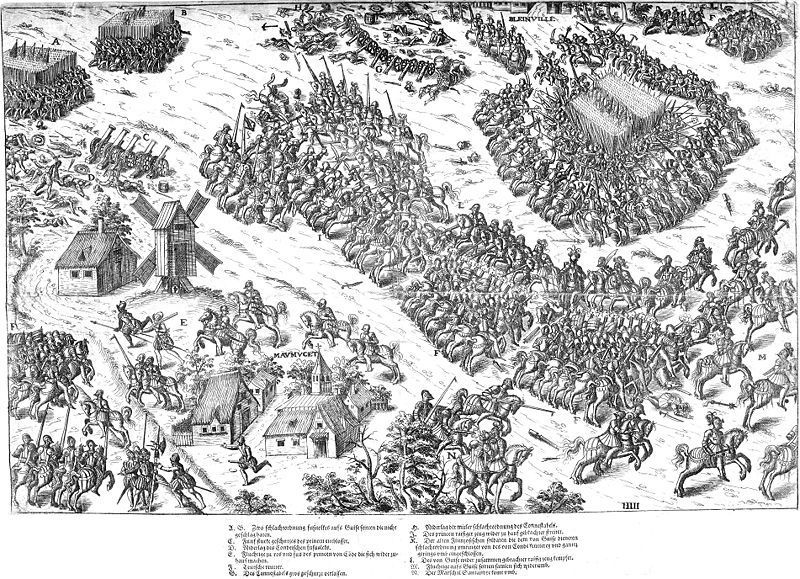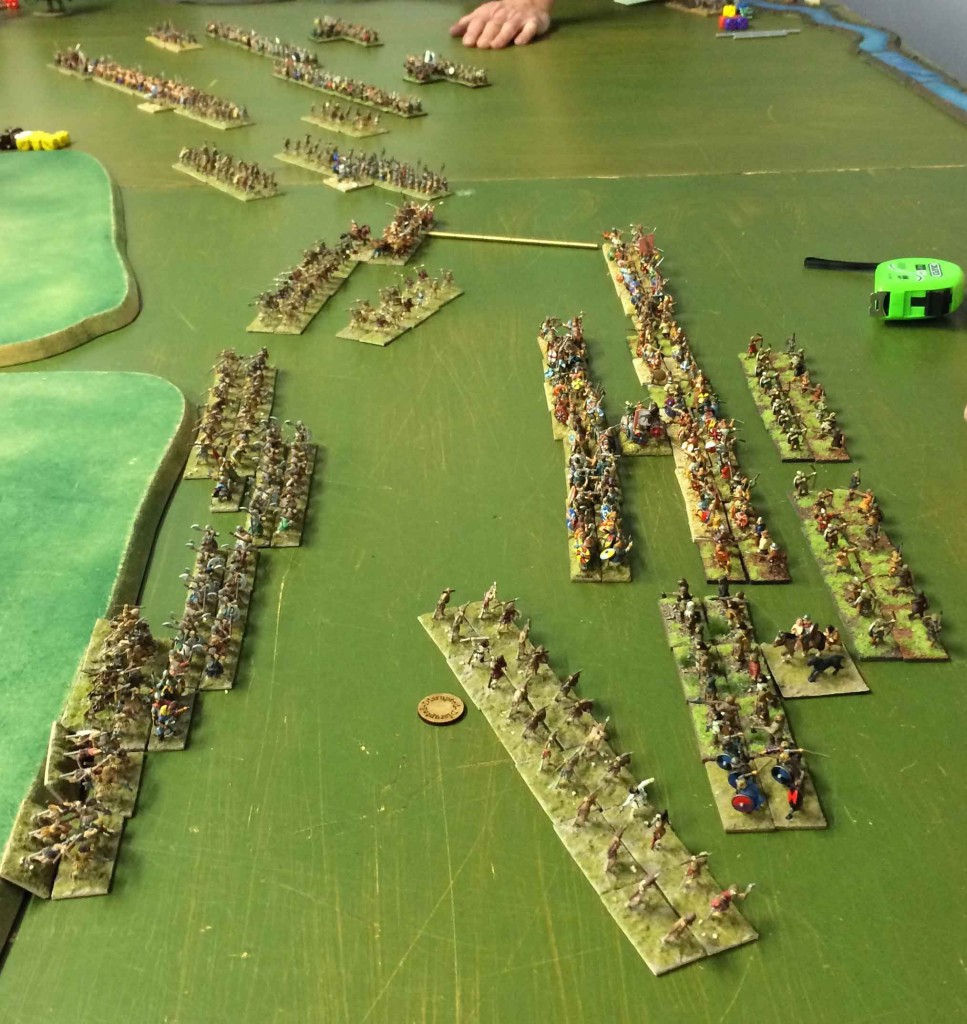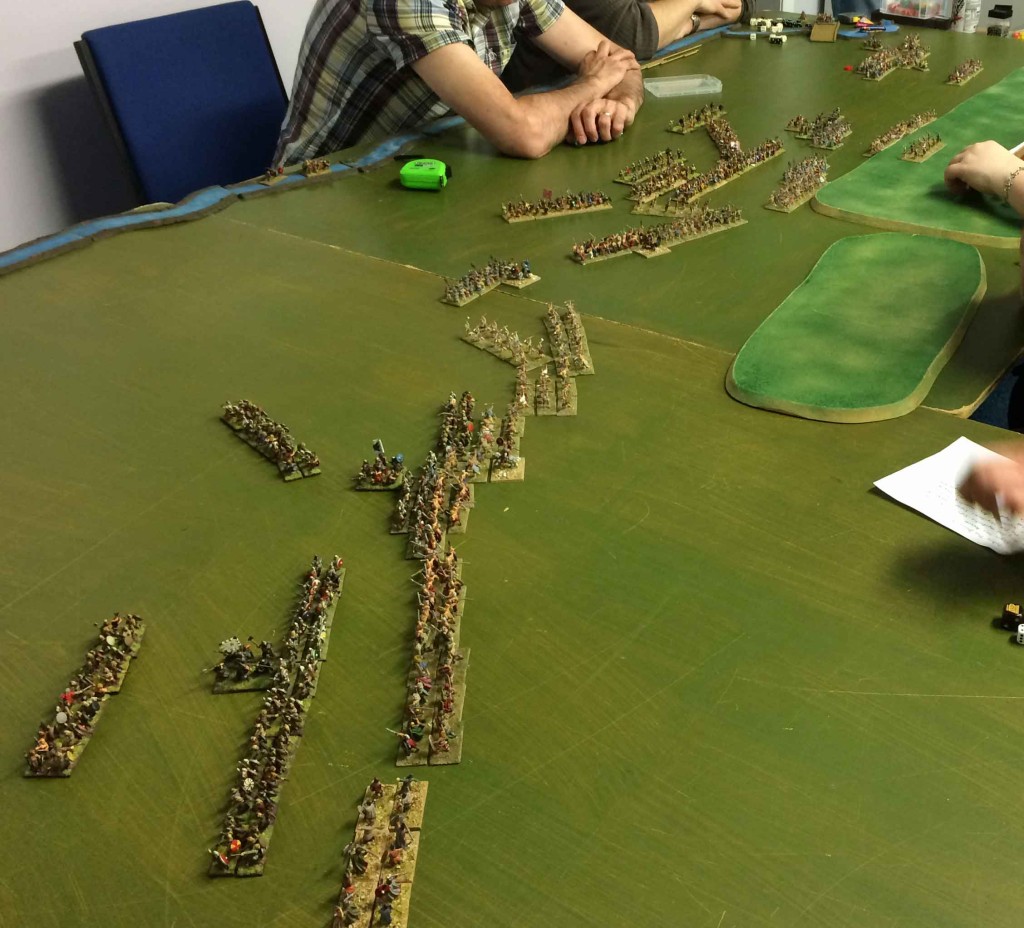GODENDAG 2017

15MM ANCIENT/MEDIEVAL/RENAISSANCE DOUBLES COMPETITIONS
28TH & 29TH JANUARY 2017
NEW VENUE:
Firestorm Games (Cardiff) (Tel: 02920 227117)
Trade Street
Penarth Road
Cardiff
CF10 5DT
United Kingdom
Mortem et Gloriam
Any published army
The list submitted must not exceed 12000 points.
Umpire and list checker: Alasdair Harley
Field of Glory: Ancient/Medieval
THE MEDIEVAL WORLD
Any army from 600 AD.
The list submitted must not exceed 900 points.
Umpire and list checker: Richard Bodley Scott.
rbs@byzant.demon.co.uk
Rules: See below
Field of Glory: Renaissance
EUROPE’S TRAGEDY
Any European army 1618-1648 (including Russia and Turkey).
The following list modifications and additional restrictions will apply:
To represent usual historical proportions in European armies of this period, ignoring artillery, the army cannot include more than 1 battle foot unit more than it has battle mounted units. (e.g. If you have 5 BGs of mounted battle troops, you can have up to 6 BGs of foot battle troops).
No more than half of all mounted battle troops can be Superior or Elite. Armies with insufficient Superior mounted battle troops in their army list to achieve this limit can upgrade whichever type of Average mounted troops in their list is most expensive in points to Superior to achieve the above limit.
No more than half of all foot battle troops can be Superior or Elite.
The army must have at least 6 bases of foot battle troops per heavy or medium artillery base.
The list submitted must not exceed 900 points.
Umpire and list checker: Richard Bodley Scott. rbs@byzant.demon.co.uk
Rules: See below
DBM
Any army. List not to exceed 500 points.
Umpire and list checker: John Graham-Leigh
jandagraham-leigh@blueyonder.co.uk
L’Art de la Guerre
400 points doubles, made up of 2 x 200 point armies (each army must be no more than 210 points with a total combined army size of maximum 400 points). The armies chosen must be listed as potential allies in either army list.
Armies drawn from Ancient Period, Classical Period and Roman Period lists (1-124 inclusive)
4 Games, same games times as the other periods
Umpire and list checker: Mike Baldwin
———————————————————————-
Cost: £ 25.00 per team of 2.
(Food will be available on site, but is not included in the entry price).
Tickets are available from Firestorm’s web site: http://www.firestormgames.co.uk/events
CONTACT: RICHARD BODLEY SCOTT, 28 PRIORY GARDENS, USK, MONMOUTHSHIRE, NP5 1AJ (RBS@BYZANT.DEMON.CO.UK)
———————————————————————–
GODENDAG 2017
VENUE:
Firestorm Games (Cardiff)
Trade Street
Penarth Road
Cardiff
CF10 5DT
United Kingdom
Tel: +44 (0) 2920 227117
TIME: 8.30 – 9.00 – Registration time on Saturday
Games will be:
Saturday: 9.30 – 1.00 and 2.00 – 5.30
Sunday: 9.00 – 12.30 and 1.30 – 5.00
ENTRANCE: £ 25.00 per team of 2. (Food will be available on site, but is not included in the entry price). Tickets are available from Firestorm’s web site:
LOCAL ATTRACTIONS:
If you are able to make a long weekend of it, there are numerous local historical attractions relevant to our period. These include the Roman Legionary Fortress and Museum at Caerleon and the Roman walled city of Caerwent. Among the many local castles, the best are Chepstow, Raglan, White Castle (at Llantilio Croesenny) and Caerphilly. Caerphilly castle has a permanent exhibition of full size working medieval siege engines including ballista, mangonel, trebuchet and perrier. The Welsh Folk Museum at St. Fagans is worth a visit. The Brecon Beacons National Park and the picturesque Wye Valley are also nearby.
QUERIES: Richard Bodley Scott, 28, Priory Gardens, Usk, Gwent, NP5 1AJ. (rbs@byzant.demon.co.uk)
————————–
FOGAM/FOGR TOURNAMENT RULES
1) Godendag is a Doubles competition. Each army is to be commanded by 2 players. Consideration will be given, however, to entries with only one player or three players if there are special circumstances.
2) The rules to be used are the current Field of Glory rules, together with the latest errata and FAQ posted on the official Field of Glory web site.
3) The competition will use the full rules including the terrain and set-up appendices. There will be no formal division of the battle groups comprising each army between the members of a team. It is usual, however, for each player to take control of the troops on about half of the battlefield.
4) The scoring system will be the standard FOG tournament scoring system, where 25 points are up for grabs each game.
5) Army lists must specify the number and size of battle groups and their order of march for deployment, and the number and type of commanders chosen. They should also include the total pre-battle initiative modifier and the territories list for the army. If the detached shot option is to be used, a second list differing only in this regard must be submitted. Once an army list has been submitted it may not be changed or altered other than to correct any errors. Players may only correct their errors by making reasonable changes to their list. It is not allowed to completely re-write the list, and the list checkers decision on this is final.
6) Please note that the Godendag 2017 Field of Glory event is a single list format. Any incorrect list discovered after a game has commenced (after set up dice have been rolled) must be corrected prior to deployment if spotted in time, and fully corrected in any case before the next match.
7) Army lists must be submitted for checking in advance and must be received by the Tournament Organiser by 14th JANUARY 2017.
8) The Tournament Organiser and List Checker is Richard Bodley Scott (rbs@byzant.demon.co.uk) 28 Priory Gardens, Usk, Monmouthshire, NP5 1AJ.
9) Players must fully define their troops as they are placed on table. Figures must provide a reasonably accurate representation of the troops they are trying to represent – they must not look deliberately misleading.
10) Table size is 6′ x 4′ and players must supply their own terrain pieces. These must be to an acceptable standard, and umpires will have the discretion to remove unsightly items. In addition all figures must be representative and painted and based to an acceptable standard.
11) Players must be present and ready to start the match at the appointed time. Where a player has a reasonable excuse for arriving late the match start will be delayed by up to 30 minutes. After which time the affected player will be awarded a bye. No player will be awarded more than one bye for any reason.
12) If a player resigns from a game at any stage after the first set up dice have been rolled their opponents will be awarded maximum points, and they will be awarded 0 points.
13) Time will be called after 3 hours 20 minutes plus up to 10 minutes. Play will stop at the end of the current phase. Players may always commence games earlier than the stated time by mutual consent, in which case their game continues until time is officially called as normal.
14) Admission to the tournament is at the sole discretion of the organisers and their decision on all matters is final. CONTACT: Richard Bodley Scott, 28 Priory Gardens, Usk, Monmouthshire, NP5 1AJ

















